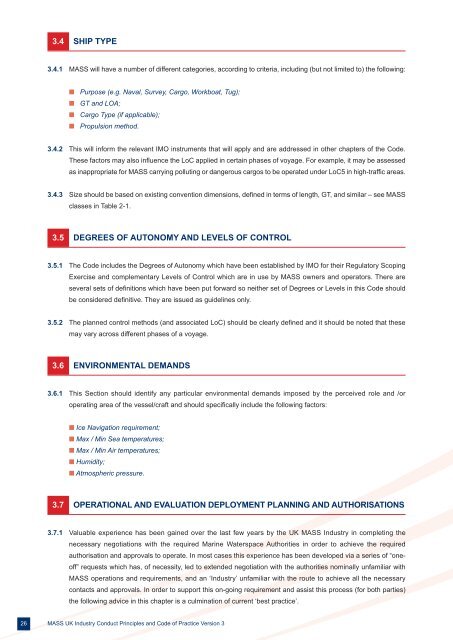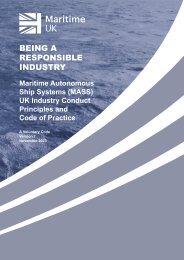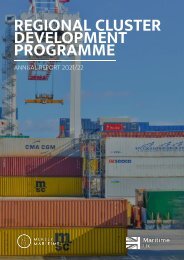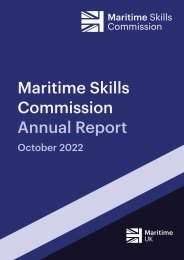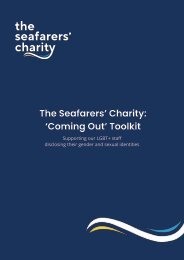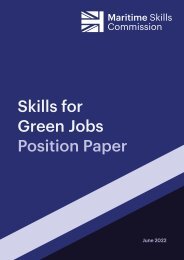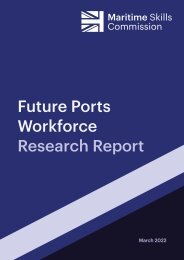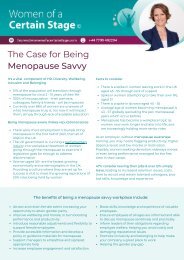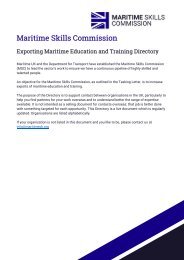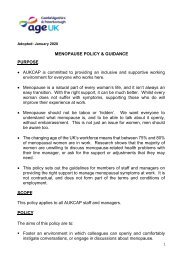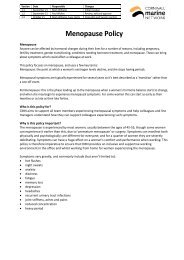code_of_practice_V3_2019
You also want an ePaper? Increase the reach of your titles
YUMPU automatically turns print PDFs into web optimized ePapers that Google loves.
3.4 SHIP TYPE<br />
3.4.1 MASS will have a number <strong>of</strong> different categories, according to criteria, including (but not limited to) the following:<br />
n Purpose (e.g. Naval, Survey, Cargo, Workboat, Tug);<br />
n GT and LOA;<br />
n Cargo Type (if applicable);<br />
n Propulsion method.<br />
3.4.2 This will inform the relevant IMO instruments that will apply and are addressed in other chapters <strong>of</strong> the Code.<br />
These factors may also influence the LoC applied in certain phases <strong>of</strong> voyage. For example, it may be assessed<br />
as inappropriate for MASS carrying polluting or dangerous cargos to be operated under LoC5 in high-traffic areas.<br />
3.4.3 Size should be based on existing convention dimensions, defined in terms <strong>of</strong> length, GT, and similar – see MASS<br />
classes in Table 2-1.<br />
3.5 DEGREES OF AUTONOMY AND LEVELS OF CONTROL<br />
3.5.1 The Code includes the Degrees <strong>of</strong> Autonomy which have been established by IMO for their Regulatory Scoping<br />
Exercise and complementary Levels <strong>of</strong> Control which are in use by MASS owners and operators. There are<br />
several sets <strong>of</strong> definitions which have been put forward so neither set <strong>of</strong> Degrees or Levels in this Code should<br />
be considered definitive. They are issued as guidelines only.<br />
3.5.2 The planned control methods (and associated LoC) should be clearly defined and it should be noted that these<br />
may vary across different phases <strong>of</strong> a voyage.<br />
3.6 ENVIRONMENTAL DEMANDS<br />
3.6.1 This Section should identify any particular environmental demands imposed by the perceived role and /or<br />
operating area <strong>of</strong> the vessel/craft and should specifically include the following factors:<br />
n Ice Navigation requirement;<br />
n Max / Min Sea temperatures;<br />
n Max / Min Air temperatures;<br />
n Humidity;<br />
n Atmospheric pressure.<br />
3.7 OPERATIONAL AND EVALUATION DEPLOYMENT PLANNING AND AUTHORISATIONS<br />
3.7.1 Valuable experience has been gained over the last few years by the UK MASS Industry in completing the<br />
necessary negotiations with the required Marine Waterspace Authorities in order to achieve the required<br />
authorisation and approvals to operate. In most cases this experience has been developed via a series <strong>of</strong> “one<strong>of</strong>f”<br />
requests which has, <strong>of</strong> necessity, led to extended negotiation with the authorities nominally unfamiliar with<br />
MASS operations and requirements, and an ‘Industry’ unfamiliar with the route to achieve all the necessary<br />
contacts and approvals. In order to support this on-going requirement and assist this process (for both parties)<br />
the following advice in this chapter is a culmination <strong>of</strong> current ‘best <strong>practice</strong>’.<br />
26 MASS UK Industry Conduct Principles and Code <strong>of</strong> Practice Version 3


